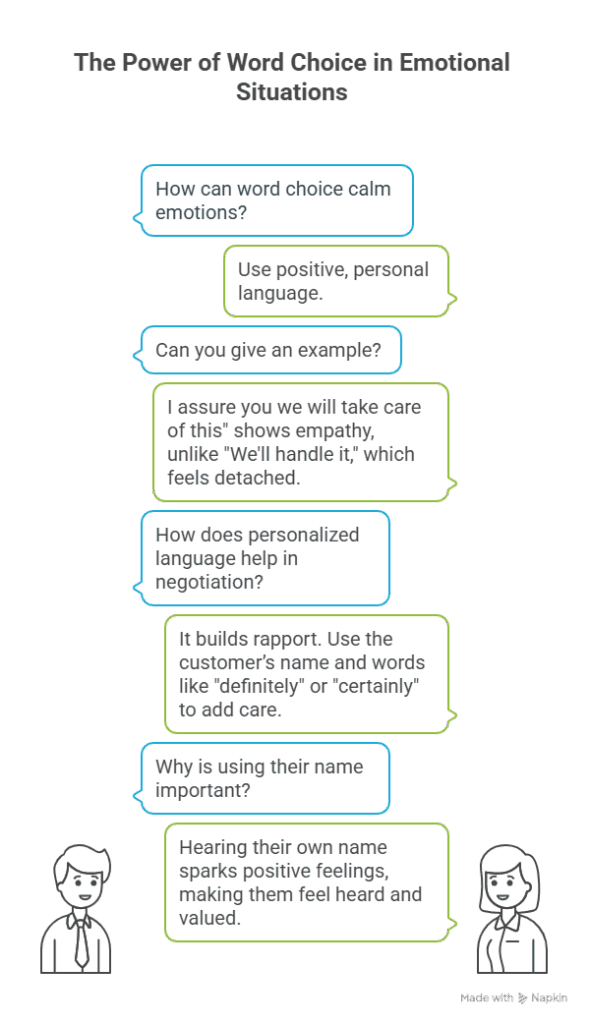What Can Negotiation Theory Teach Us About Customer Service?
05 Oct 2024 By: Maria Rush
Updated

Customer service isn’t always easy. Sometimes we must share news customers dislike, and it feels risky. Addressing complaints, enforcing rules, or explaining limits can lead to conflict. But using negotiation theory can turn these moments into chances for a positive outcome.
Here are some strong negotiation theory strategies to help handle tough conversations. Learn how to maintain customer satisfaction while protecting business goals.
Understanding the Power of Active Listening
In customer service, good listening is key. Upset customers need to feel heard. Active listening helps here. It means focusing fully, letting them speak, and confirming what you heard.
Active listening validates emotions and reduces frustration. Showing genuine care builds a cooperative tone. A phrase like, “I understand how frustrating this is,” can change everything.
Avoiding Mirroring Negative Behavior
When facing a hostile customer, our instinct might be to match their tone. But negotiation theory shows this often leads to more conflict. Mirroring negativity makes things worse.
Instead, stay focused on the goal. Psychologist Molly Ireland found that sticking to task-based language lowers conflict. Show empathy, but don’t mimic aggression. Stay calm and solution-focused.
For instance, if a customer is angry about a bill, avoid frustration. Instead, say, “Let’s work together to solve this,” and then address the issue directly.
Using Emotional Payments to Defuse Situations
In tense customer interactions, an emotional payment can ease tension. It’s not about money but acknowledging feelings. When customers feel wronged, emotions can block logic.
A well-timed apology or concession shows you understand their frustration. Saying, “I’m sorry this happened, and I see why it’s upsetting,” helps them feel heard. Repeating their issue shows you listened and gives them a sense of control.
Choosing Words Carefully for a Positive Impact
When emotions run high, word choice can calm or inflame. Positive, personal language helps. Saying, “I assure you we will take care of this” shows empathy, unlike “We’ll handle it,” which feels detached.

In negotiation theory, personalized language builds rapport. Using the customer’s name and words like “definitely” or “certainly” adds care. Hearing their own name sparks positive feelings, making them feel heard and valued.
Balancing Company Policy with Customer Satisfaction
Balancing company policies with customer happiness is tough. How do you say “no” without causing frustration? Negotiation theory helps here.
Negotiators stay firm but fair. They stand by policies without seeming rigid. For instance, if a refund request breaks company rules, don’t deny it outright. Instead, offer an option. Say, “We can’t give a refund, but we can offer credit for your next purchase.” This keeps company rules intact while maintaining goodwill.
Turning Conflict into Collaboration
Negotiation theory shows that conflict doesn’t need to be adversarial. You can turn a disagreement into collaboration. Treat tough customer talks as teamwork toward a solution.

Offer customers choices to involve them. Options give them control, even if limited. Say, “We can expedite a replacement or offer a discount on your next purchase.” This approach makes them a partner in solving the problem, not just a passive receiver.
Trending Now
Contact centers now use AI voice filters to ease stress from angry customers. These tools soften harsh tones, making interactions less draining for agents.
Companies like SoftBank blend voice processing with emotion recognition to reduce stress and boost retention. AI accent modification also helps, reducing biases and agent turnover. These advances show AI can greatly improve contact center conditions, especially since voice remains a key service channel.
Conclusion
We can’t always avoid tough customer interactions, but we can prepare. By applying negotiation theory. Active listening, avoiding mirroring, emotional payments, personalized language, balancing policy, and collaboration. We turn tough talks into positive outcomes.
These tools help solve problems and build strong, lasting relationships. They create a path where customer service moves beyond resolving issues to truly connecting with customers.
At HelpSquad, our live chat answering service equips our agents with the negotiation skills needed to handle customer conversations with care, professionalism, and empathy. Ready to provide the best possible customer experience? Our highly trained, U.S.-based live chat agents are here to help.
Healthcare Transformation FAQs
The technology revolution, growth of the elderly population, and rising patient expectations are defining the future of healthcare. AI, data, and telehealth are transforming care delivery; the aging population requires more preventive care, and patients expect hassle-free access, electronic data, and personalized on-demand care.
AI helps medical workers make faster, more accurate diagnoses and automates tasks like patient communication and appointment booking. Telemedicine and remote monitoring allow online consultations and data sharing from wearable devices, helping prevent issues earlier, reduce hospital visits, and extend care to isolated or remote patients.
Forecasting healthcare trends helps organizations and health systems budget, plan staffing, and prepare technology for future patient needs. Policymakers use these projections to regulate the sector efficiently, stimulate innovation, and ensure patient safety amid rising global health challenges and costs.
Key trends for 2025 include wider usage of AI, telemedicine, and remote patient monitoring; stronger patient expectations for both curative and preventive care; and a shift toward patient-focused, customized treatment. Hospitals are investing heavily in technology, AI, and data security to reduce paperwork, protect data, and improve patient and staff experience.
Policy and regulatory changes expand coverage for preventive care, mental health, and chronic disease treatment while rewarding quality over volume in value-based care models. New telehealth and data privacy regulations push providers to upgrade technology and security systems, improve access to online consultations, and increase patient trust in data handling.


